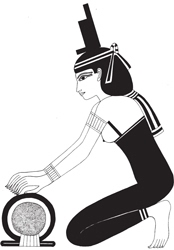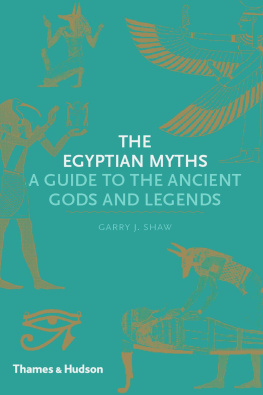BECOMING OSIRIS

THE ANCIENT EGYPTIAN DEATH EXPERIENCE
Ruth Schumann Antelme and Stphane Rossini
Translated from the French by Jon Graham

Inner Traditions
Rochester, Vermont
Translators Preface
The elaborate rituals of death and rebirth in ancient Egypt were a core focus of its spiritual life. The ancient Egyptians believed it was in the tomb that heaven and earth, and life and death converged most closely. In Becoming Osiris, Professor Schumann Antelme makes it clear that the Egyptians viewed the tomb as a remote-control switch that caused actions in heaven in response to the terrestrial activities with which they were associated. This concept can be summed up best by the alchemists celebrated formula of as above, so below, which in other words means that there is a precise correspondence between heaven and earth. This theory is also the rationale behind astrology and other esoteric doctrines. The alchemical tradition, and all religious tradition, had its origin in the sacred science of the ancient Egyptians.
Much of this ritual is still imperfectly understood and has remained the province of scholars of Egyptology. Even in Professor Schumann Antelmes detailed accounts, which make this rich legacy more accessible than ever before, certain elements still may present a mystery to those readers with little previous exposure to Egyptian theological thought. These complex rituals that comprised an intrinsic part of the ancient Egyptian death experience are intimately connected with the story of Osiris, son of Geb, the Neter (god) of the earth, and Nut, the Neter of the heavens, in which we encounter one of the oldest forms of the myth of resurrection. This myth is an integral part of all the death rituals explored in Becoming Osiris, and it is worthwhile to encapsulate the main features of the story here.
In the time when the gods still ruled Egypt, Osiris assumed the throne of the two lands from his father, who had assumed it in turn from Atum-Ra, the creator of the world. Despite the excellence of Osiriss rule, with his sister-consort Isis (in this text they are are often referred to as the Divine Couple), his brother Seth contrived to overthrow him. With the help of seventy-two accomplices, Seth organized a festival during which a trunk the size of Osiris was brought in. Despite the efforts of all in attendance, the only one who could fit into the trunk was the Neter Osiris. Once Osiris was inside the trunk, it was closed and locked by Seths accomplices who set it adrift on the Nile. By the use of her arts, Isis was able to reclaim the body of Osiris from the trunk, but before she could restore him to life the Neter Seth took possession of the trunk and dismembered Osiriss body into sixteen pieces, which he scattered throughout Egypt. Taking up her quest anew, at each site where a portion of Osiriss body was found Isis had a temple erected. In order to prevent any recurrence of the evil deed of dismemberment, Horus, the posthumous son of the Divine Couple, embarked on an eternal war against Seth and his followers: the battle of Good and Evil on a cosmic level.
Until the murder of Osiris, the Neter had not known the experience of death, and this event forced them to seek a way by which to escape it. It fell to Horus (with the aid of Isis) to enter the Dwat and restore life to the inert form of Osiris with the power of his healing eye, a mythological journey reenacted by the magic funeral rites. For humans, and, first, for the King-Horus, the rites consisted of reproducing the circumstances of the death and resurrection of the Neter as faithfully as possible. Over the course of the ceremony, these episodes were acted out with the aim of reinserting the dead into the universal cosmic cycle. Animal sacrifices of beasts (representing Seth) were performed by Horus in a symbolic gesture that transformed back from son to father the life force he had inherited. (Schumann Antelme points out that there are striking illustrations of this in the tomb of the Pharaoh Tutankhamen.)
These rituals recounted in Osiriss passion became the deliverance of humanity, and it was deemed necessary to repeat the resurrection rites for all. With the help of these same ceremonies, it became possible for every human to achieve a similar objective: that of immortal life as a solarized beingan Osiris-Ra. In the reenactment of this myth incorporated into funeral ceremonies, priests and/or sons played the role of Horus; wives, the role of Isis; priests and friends, the roles of Thoth and Anubis.
In the same text of the Corpus Hermeticum in which Hermes referred to Egypt as the image of heaven, he prophesied a coming period in which the temples of Egypt would be abandoned and the voices of the gods would no longer be heard, and at which time humanity would prefer darkness to light. But he went on to say that this would prompt a revival of sacred consciousness in which the temples would be restored. Such a revival seems to be occurring in the world today with books such as this providing the modern spiritual seeker with a bridge to an ancient spiritual tradition that reveals itself to be increasingly relevant to these times in which we live.
Jon Graham
Hail to thee, Osiris, son of Nut, possessor of two horns and the high Atef crown; to whom the white crown and the scepter have been given in the presence of the Ennead; for whom Atum has created awe in the hearts of men, of gods, of the grateful, and of the dead; prince of the gods of Dwat; great power of heaven, governor of the living and king of the dead, glorified by thousands.
Thy son Horus is thy protector, he chases away all evil bound to thee. Raise thyself Osiris, forever living! Geb has wiped thy mouth; thy mother Nut places her hands behind thee, she protects thee; thou art great with rebirths.

Thy two sisters, Isis and Nephthys, come unto thee and endow thee with life, health, and strength; thy heart expands in their presence; they put for thee all things into your arms; they (are delighted) by thee, by their love for thee they unite for thee all the gods and Kas; they adore thee eternally.
Thou art handsome, Osiris! Thou hast appeared in glory, powerful, glorious. Thou hast fixed thy forms; thy countenance is Anubis.
Ra rejoices in thee and combines with thy perfection, for thou hast seated thyself on his pure throne, created for thee by Geb who loves thee; the protection of Ra is thy safeguard; the magical formulas of Thoth accompany thee and the protective incantations of Isis have entered all thy limbs.
I am coming toward thee, master of the sacred country, Osiris chief of the Westerners, Wennofer who exists forever and ever.
Hymn to Osiris
(excerpts from chapter 181 of the Book of the Dead)

Isis and Nephthys, the two sisters, the two Divine Weepers, who have assumed a magical attitude of protection for the new Osiris.

The candidate for immortality saluting the divine powers.
CHAPTER 1
Ancient Egypt in Context
Next page












